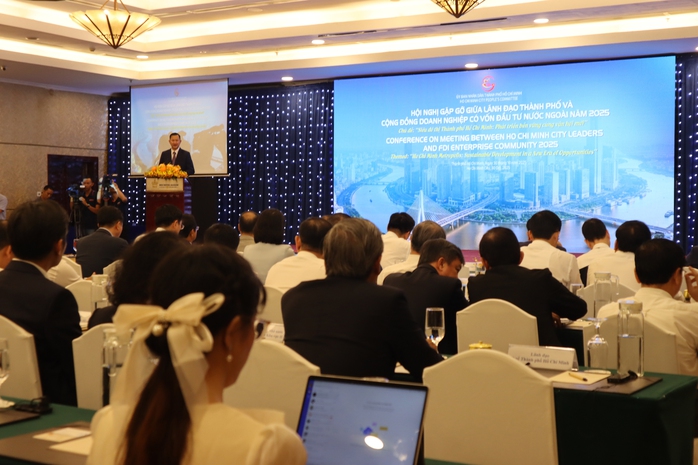Ho Chi Minh City emerges as a premier destination for FDI
(NLĐO) - Ho Chi Minh City is committed to accompanying enterprises from the idea stage through project implementation.
The Ho Chi Minh City Trade and Investment Promotion Center (ITPC) recently hosted a dialogue between city leaders and the foreign direct investment (FDI) business community, themed "Ho Chi Minh City Megacity: Sustainable development amid new opportunities".
Strengthening investor confidence
At the conference, Truong Minh Huy Vu, Director of the Ho Chi Minh City Institute for Development Research, highlighted the city's advantages following the merger of three localities, positioning it as a unique administrative-economic entity capable of mutual support across multiple sectors.
The city's spatial development framework has been reshaped into "three zones, one special district, three corridors, and five pillars."
Ho Chi Minh City aims to evolve into a multi-center megacity, anchored by five key pillars: high-tech industry; logistics integrated with seaports, airports, and free trade zones; an international financial center; tourism and cultural industries; and education, healthcare, and science-technology.
Nguyen Thanh Toan, deputy director of the Department of Finance, noted that the merger has unlocked new investment opportunities for global corporations in three priority areas: high-value services, healthcare-education, and finance. He predicted that the International Financial Center in Ho Chi Minh City will become a cornerstone in the coming decade, drawing in investment funds, banks, and multinational financial firms.
Meanwhile, the former Bình Dương area is set to emerge as a high-tech hub, fostering smart technologies built on existing industrial parks. The erstwhile Ba Ria - Vung Tau region will accelerate marine economic growth, resort tourism, and logistics port systems, including major projects like Cai Mep Ha and free trade zones.
From the international business perspective, Travis Mitchell, executive director of the American Chamber of Commerce (AmCham), observed that global turbulence is exerting pressure on Vietnam, especially when U.S. imposes new tariff measures.
Amid rising production costs, Mitchell stressed the need for a stable and reliable investment climate. Timely business licensing, consistent tax and fee policies across localities, and streamlined customs procedures are essential to bolstering trust among international firms.
Erick Contreras, Vice Chairman of the European Chamber of Commerce (EuroCham), added that European investors' confidence in Vietnam remains robust. More than two-thirds of EuroCham members view Vietnam's short-term outlook as positive and stable, while 80% express faith in its growth potential over the next five years.
Contreras attributed this optimism to Vietnam's sound reform policies, strategic development direction under the government, and Ho Chi Minh City's pioneering role in attracting investment and fostering innovation.

The conference drew around 400 delegates, including leaders from city departments and sectors, representatives from associations, and FDI enterprises operating in Ho Chi Minh City. Photo: SƠN NHUNG
Tackling persistent hurdles
Mr. Erick Contreras also frankly pointed out areas that need improvement for Ho Chi Minh City to attract more FDI enterprises. Specifically, delays in customs clearance remain a concern for European businesses. Congestion at airports and complicated immigration procedures also affect logistics operations and supply chains.
Mr. Contreras proposed that Ho Chi Minh City improve customs procedures and increase staffing at key stages. He also suggested upgrading infrastructure that connects airports with logistics hubs to shorten cargo transportation time.
In the field of urban transportation, Mr. Contreras praised the metro projects currently underway and the expanding electric bus network, considering them positive signals toward developing a green urban environment. He suggested that the city should soon integrate a multimodal public transport system to reduce congestion, cut emissions, and improve quality of life for residents.
Presiding over the conference, Ho Chi Minh City People’s Committee Chairman Nguyen Van Duoc acknowledged that the city is facing a number of challenges, including traffic congestion, flooding and environmental pollution, as well as complicated administrative procedures that continue to trouble businesses, particularly foreign-invested enterprises. These obstacles not only increase operational costs but also cause investors to miss out on opportunities.
The chairman noted that feedback from businesses serves as a crucial basis for the city to refine policies and address shortcomings, thereby sustaining rapid, sustainable and high-quality growth. Ho Chi Minh City, he affirmed, is committed to accompanying enterprises from the idea stage through project implementation, creating favorable conditions for their development and contributions to shared prosperity.
According to Chairman Nguyen Van Duoc, Ho Chi Minh City is concentrating its resources and expertise on finalizing its comprehensive urban development plan, viewing it as the foundation for effective management and governance.
The city will continue working with international corporations and domestic partners to fully unlock the potential of the Binh Dương – Ba Ria-Vung Tau – Ho Chi Minh City growth triangle, creating a regional development synergy.
The chairman stressed that regional connectivity is a strategic priority for the city, centered on three main development corridors. The north–south corridor along the Saigon River toward the sea is envisioned as a high-tech industrial axis. The eastern corridor, linking Bà Rịa-Vũng Tàu with Cần Giờ, focuses on the maritime economy, renewable energy and tourism. Meanwhile, the east-west corridor connecting Ho Chi Minh City with Đồng Nai and Tây Ninh via National Highway 1 and the Trans-Asia route aims to ensure balanced and sustainable regional development.
Chairman Nguyen Van Duoc emphasized regional connectivity as a strategic priority, centered on three main corridors. The North-South corridor along the Saigon River toward the sea will drive high-tech industry. The Eastern corridor linking Ba Ria - Vung Tau with Can Gio will focus on marine economy, renewable energy, and tourism. The East-West corridor connecting Ho Chi Minh City to Dong Nai and Tay Ninh via National Highway 1 and the Asian Highway will promote balanced, sustainable expansion.
